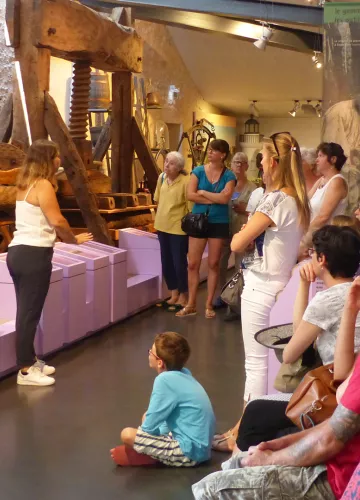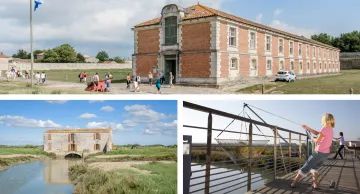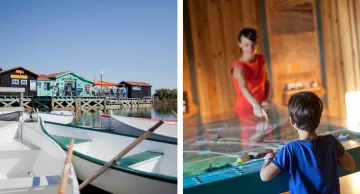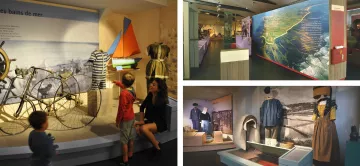
Museums
The bassin de Marennes and the île d’Oléron boast a significant number of museums. In the bassin de Marennes area there are several museums and exhibition spaces.
From oysters to military architecture
Built in the 17th century to store provisions for the garrison of the citadel of Brouage, the Halle aux Vivres (the food store) is now a ground floor space containing exhibits and displays on the history of Brouage, military architecture and trading links with the Atlantic region. Make sure you don’t miss the replica of the 3-D model from 1703 in the middle of the room, which will help visitors to grasp how important the town was in the 17th century. Other scale models, recently-made by a specialist scale model manufacturer, add a visual aspect to the exhibition. Upstairs, an archive is open to researchers, fans of military history and members of the general public interested in seeing reference works on the history of Brouage and its surrounding marshes, military architecture from the medieval period to the 20th century and Samuel de Champlain and Canadian history.

Museums to suit all tastes in Marennes-Oléron
In Marennes, by the La Cayenne channel, the Cité de l’Huître oyster centre offers a fun, interactive look at oyster farming as it’s currently practised in the bassin Marennes-Oléron area. Follow oysters on their adventure from the open sea to special oyster beds before finally tasting them! Each oyster shed on the discovery trail explores a different theme, enabling you to find out all about the various life-stages of the oyster. You can also enjoy a film on a big screen entitled ‘Entre terre et mer’ (between sea and land), an introduction to the area where Marennes Oléron oysters are raised, seen from the perspective of the sky, the land and the sea. Lastly, if you fancy stretching your legs, the Cité de l'Huître will lend you bicycles to allow you to visit this amazing natural habitat. You might want to take the ‘Chemin des Claires’, a long loop (4 km) which starts at the Cité de l'huître, taking you through the middle of the marshes and the oyster beds. There are also numerous special events for both young and old, right throughout the year. These include sessions on how to open oysters aimed at beginners and warm oyster tasting sessions.
Did you know that the Chemins de la Seudre, a marked foot- and cycle-path, will take you right through the middle of the oyster beds, enabling you to discover the kingdom of the ‘pousse en claire’, the caviar of the Marennes Oléron oyster world. The Chemins de la Seudre network is located between Marennes and La Tremblade and contains a total of 108 km of peaceful paths.
To finish off in the bassin de Marennes, don’t forget to stop off at the Moulin des Loges tide mill in Saint-Just-Luzac. At the heart of the old salt marshes of la Seudre is the only tide mill in the whole region. Restored in the 2000s, it’s now one of the last operational tide mills in Europe. This site can be visited with or without a guide. The guided tour lasts around 45 minutes and takes you through the history of this 18th century mill. Your guide will reveal the mysteries of a working mechanism that’s man-made but which is intimately connected with its surrounding natural habitat. From April to October you can also see grinding demonstrations. On leaving the mill, let your curiosity take you as far as the discovery trail which looks back over the activities that have shaped this place – oyster farming, salt production, fish ponds and livestock rearing.
Arouse your curiosity on the île d'Oléron
After you cross the bridge to Grand-Village-Plage, you’ll come across the Port des Salines, a centre where you can discover the salt marsh through a variety of means, including an eco-museum, a guided tour, a boat trip and an interpretive trail. Amidst brightly-coloured shacks, the whole family can explore the world of salt production and the marsh in a fun way thanks to educational models, a fun discovery trail and kids’ workshops. Foodies will enjoy learning about the history of ‘white gold’ - sea salt – as well as the chance to try it out during tasting tours or when sampling light snacks on the boat trip.

Staying with Grand-Village-Plage, the Maison éco-paysanne will leave you with a better understanding of the kind of houses people on the island used to live in, as well as eco-friendly construction techniques from the past and the future thanks to a modern, interactive exhibition. The site consists of a typical Oléron farm made up of a dwelling house, barns and wine cellars, opening a window onto day-to-day local life at the end of the 19th century. Stroll through the garden and wander around the buildings – restored through community volunteering projects designed to introduce people to traditional skills and eco-friendly materials. This is all rounded off by the interpretive centre where you can really get a feel for the building designs with the help of scale models and a materials resource centre. Videos, personal accounts and fun events will whisk you into the world of the villages of the île d'Oléron and the eco-villages of the 21st century.

At the heart of Saint-Pierre d'Oléron you’ll find the Musée de l’île d’Oléron. This museum brings together over 500 items relating to local life and traditional island activities and occupations. Spread over 600m², different themes are examined: salt production, wine-making, fishing, traditional costumes and housing. A comprehensively-equipped museum (with films, soundscapes, a discovery trail for kids and a tactile model of a salt marsh). The museum puts on a wide variety of exhibitions and special events throughout the year catering to all tastes: tasting sessions, guided tours etc.

Lastly, Saint-Denis d’Oléron at the island’s northernmost point is home to an audio-guided museum experience housed in the rotunda of the Chassiron lighthouse. This will introduce you to the everyday life and know-how of the people who lived on this coastline, as at ease on the sea as on dry land.